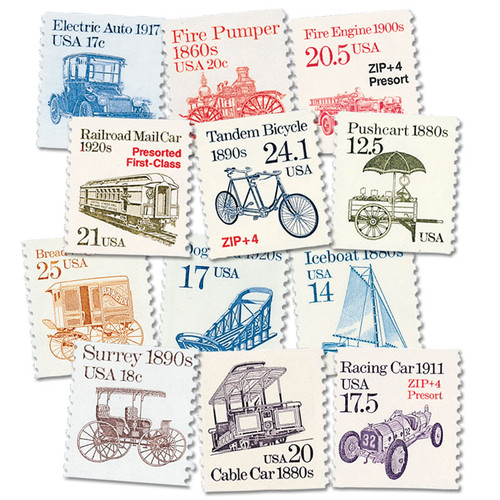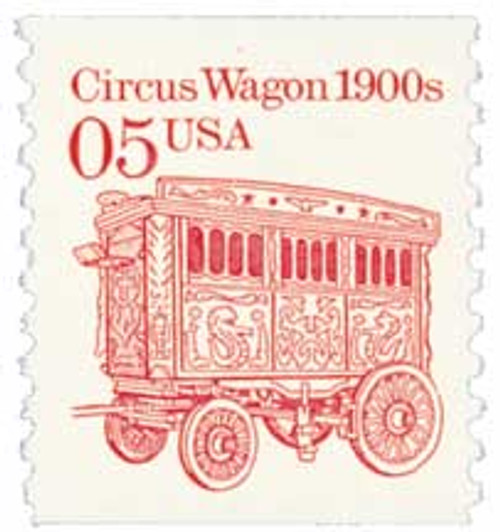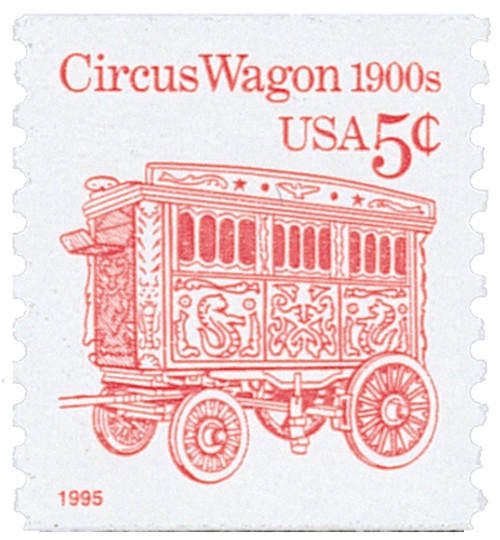
# 2464 FDC - 1991 23c Transportation Series: Lunch Wagon, 1890s
US #2464
1991 Lunch Wagon
- First coil stamp in Transportation Series to be tagged
- 9th in series to picture a wagon
- Used to pay additional ounce rate
Category of Stamp: Definitive
Set: Transportation Series
Value: 23¢
First Day of Issue: April 12, 1991
First Day City: Columbus, Ohio
Quantity Issued: 595,092,000
Printed by: Bureau of Engraving and Printing
Printing Method: Engraved
Format: Coils of 100, 500 and 3,000, from sleeve of 864 subjects (18 across, 48 down)
Perforations: 9.8
Reason the stamp was issued: The 23¢ stamp would have been used to pay the Frist-Class mail rate for each additional ounce.
About the stamp design: The stamp pictures a lunch wagon like those found in cities around the turn of the 20th century. Artist Robert Brangwynne used the lunch wagon known as “The Owl” as his inspiration.
First Day City: The Lunch Wagon stamp was issued at the Colopex stamp show in Columbus, Ohio.
Unusual thing about this stamp: This stamp was the first coil stamp in the Transportation series to be printed on phosphor-coated paper.
About the Transportation Series: On May 18, 1981, the USPS issued the first stamp in the Transportation Series, US #1907, picturing the Surrey, a doorless four-wheeled carriage. For the first time in US history, a coil stamp featured its own unique design rather than simply copying that of the current definitive stamp. Over 50 more coil stamps would be issued over the course of the next 15 years, each picturing a different mode of transportation. All of these types of transportation were used since American independence.
The various denominations provided face values to exactly match the rates for several categories of Third-Class mail (bulk rate and quantity-discounted mail). As the rates changed, new stamps with new values were added. Never before had a stamp series included so many fractional cent values.
The Bureau of Engraving and Printing printed most of the stamps in the Transportation Series, although private contractors printed a few. All but a few of the later stamps were produced by engraved intaglio. Differences in precancels, tagging, paper and gum provide a large number of varieties.
Scott Catalog separates the Transportation stamps into four groups. The stamps in the first group (#1897-1908) generally have the denomination in small type with a “c” next to it. These stamps were printed on the Cottrell rotary press, which joined together two plates to make a sleeve. The gaps between these plates created depressions where ink would collect and create joint lines on the stamps. Later issues were printed on a different press and didn’t have these joint lines.
The second group (#2123-36) had larger numbers with no “c.” The third group (#2252-66) was similar in appearance to the second group, but service inscriptions were added to the designs. These stamps also used a variety of paper and gum as well as different types of tagging. The fourth group (#2451-68) marked the end of fractional values. Now bulk mailers would use either the 5¢ or 10¢ stamp and then pay the difference from the actual postage rate.
The last stamp in the Transportation Series, the 20¢ Cog Railway, was issued on June 9, 1995, at the TEXPEX ’95 stamp show in Dallas, Texas. This marked the end of the largest US definitive series up to that time. Three new series would eventually replace it – American Transportation, American Culture, and American Scenes. Additionally, the Great Americans would go on to become the largest American definitive series.
History the stamp represents: A forerunner of the 20th century diner, lunch wagons were used in the 1800s to deliver meals to the public in American cities. These enclosed wagons had a kitchen in the rear which was separated from the dining area by a window to pass food out to customers on the street. Another window was situated on one side so patrons could drive up and place an order from their carriage. During cold, stormy months, these popular eateries were packed with customers. In the summer, however, people preferred to eat outdoors.
The lunch wagon pictured on the stamp was manufactured by Charles Palmer of Massachusetts. He produced two models, “The Owl” shown on the stamp was a night lunch wagon and was more casual. “The Star” was known as a fancy night café and was more formal.
US #2464
1991 Lunch Wagon
- First coil stamp in Transportation Series to be tagged
- 9th in series to picture a wagon
- Used to pay additional ounce rate
Category of Stamp: Definitive
Set: Transportation Series
Value: 23¢
First Day of Issue: April 12, 1991
First Day City: Columbus, Ohio
Quantity Issued: 595,092,000
Printed by: Bureau of Engraving and Printing
Printing Method: Engraved
Format: Coils of 100, 500 and 3,000, from sleeve of 864 subjects (18 across, 48 down)
Perforations: 9.8
Reason the stamp was issued: The 23¢ stamp would have been used to pay the Frist-Class mail rate for each additional ounce.
About the stamp design: The stamp pictures a lunch wagon like those found in cities around the turn of the 20th century. Artist Robert Brangwynne used the lunch wagon known as “The Owl” as his inspiration.
First Day City: The Lunch Wagon stamp was issued at the Colopex stamp show in Columbus, Ohio.
Unusual thing about this stamp: This stamp was the first coil stamp in the Transportation series to be printed on phosphor-coated paper.
About the Transportation Series: On May 18, 1981, the USPS issued the first stamp in the Transportation Series, US #1907, picturing the Surrey, a doorless four-wheeled carriage. For the first time in US history, a coil stamp featured its own unique design rather than simply copying that of the current definitive stamp. Over 50 more coil stamps would be issued over the course of the next 15 years, each picturing a different mode of transportation. All of these types of transportation were used since American independence.
The various denominations provided face values to exactly match the rates for several categories of Third-Class mail (bulk rate and quantity-discounted mail). As the rates changed, new stamps with new values were added. Never before had a stamp series included so many fractional cent values.
The Bureau of Engraving and Printing printed most of the stamps in the Transportation Series, although private contractors printed a few. All but a few of the later stamps were produced by engraved intaglio. Differences in precancels, tagging, paper and gum provide a large number of varieties.
Scott Catalog separates the Transportation stamps into four groups. The stamps in the first group (#1897-1908) generally have the denomination in small type with a “c” next to it. These stamps were printed on the Cottrell rotary press, which joined together two plates to make a sleeve. The gaps between these plates created depressions where ink would collect and create joint lines on the stamps. Later issues were printed on a different press and didn’t have these joint lines.
The second group (#2123-36) had larger numbers with no “c.” The third group (#2252-66) was similar in appearance to the second group, but service inscriptions were added to the designs. These stamps also used a variety of paper and gum as well as different types of tagging. The fourth group (#2451-68) marked the end of fractional values. Now bulk mailers would use either the 5¢ or 10¢ stamp and then pay the difference from the actual postage rate.
The last stamp in the Transportation Series, the 20¢ Cog Railway, was issued on June 9, 1995, at the TEXPEX ’95 stamp show in Dallas, Texas. This marked the end of the largest US definitive series up to that time. Three new series would eventually replace it – American Transportation, American Culture, and American Scenes. Additionally, the Great Americans would go on to become the largest American definitive series.
History the stamp represents: A forerunner of the 20th century diner, lunch wagons were used in the 1800s to deliver meals to the public in American cities. These enclosed wagons had a kitchen in the rear which was separated from the dining area by a window to pass food out to customers on the street. Another window was situated on one side so patrons could drive up and place an order from their carriage. During cold, stormy months, these popular eateries were packed with customers. In the summer, however, people preferred to eat outdoors.
The lunch wagon pictured on the stamp was manufactured by Charles Palmer of Massachusetts. He produced two models, “The Owl” shown on the stamp was a night lunch wagon and was more casual. “The Star” was known as a fancy night café and was more formal.
















